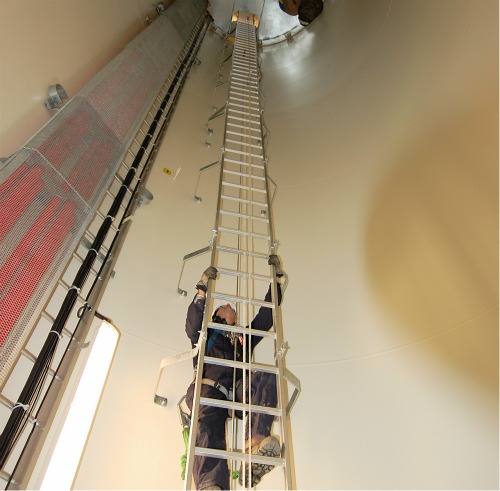 After an 18-month-plus delay, the Occupational Safety and Health Administration (OSHA) reiterated its position that fixed ladders inside wind turbines must adhere to 29 CFR 1910.27 – its standard pertaining to fixed ladders.
After an 18-month-plus delay, the Occupational Safety and Health Administration (OSHA) reiterated its position that fixed ladders inside wind turbines must adhere to 29 CFR 1910.27 – its standard pertaining to fixed ladders.
OSHA's Jan. 31 letter of interpretation (LOI) addressed the ongoing issue of ladder clearances inside wind towers.
Per 29 CFR 1910.27, fixed ladders require a clearance of 30 inches from the ladder to allow technicians to safely ascend and descend. OSHA defines minimum clearances from fixed ladders to the "nearest permanent object" on the climbing side of the ladder and states that there shall be no potential hazards within 24 inches.
A typical wind tower is manufactured in three sections and is fastened together by a series of bolts and flanges. However, the flanges – some of which protrude several inches into the technician's safety space – may reduce clearance on the climbing side of the fixed ladder to less than 30 inches, creating a protruding hazard for workers ascending or descending the ladder on the climbing side of the fixed ladder.
If there are permanent obstructions within the climbing space, OSHA requires that they be shielded. In its LOI, OSHA reiterated its requirement.
‘Use of a deflector plate, placed at an angle of 60 degrees from the horizontal will achieve compliance with the standard,’ OSHA said.
‘To clarify our position, ladders found in wind turbine generators installed in the United States must be designed and constructed to comply with 29 CFR 1910.27, as well as [with] any other applicable OSHA standards," OSHA added. "29 CFR 1910.27 (h), which also applies to wind power generating facilities, specifically requires that the ladders used at power generation facilities, such as wind turbines, comply with OSHA subpart D requirements.’
While the LOI clarified OSHA's position, the ruling does not include specific instructions for how owners and operators can comply with the rules. Notably, the LOI leaves unanswered questions regarding the requirements and deadlines for compliance.
‘The LOI was narrow in scope,’ admits Michelle Mihelic, the American Wind Energy Association's (AWEA) manager for labor, health and safety policy.
For her part, Mihelic acknowledges that applying a blanket standard to wind towers can be challenging because even though towers and turbines perform similar functions, they have different designs that have to be taken into account.
Just the same, she says the wind industry will continue to work with and educate OSHA about the wind industry's nuances. These steps include working toward a set of best practices to ensure workers are safe when they ascend and descend towers.
Additionally, AWEA expects further clarity resulting from the OSHA Alliance, an initiative between AWEA and OSHA that aims to protect the health and safety of the wind industry's workers.
‘Our next meeting will be held in March, and we discussed during our implementation meeting call about creating another work group to address climb safety and ladders,’ Mihelic notes.
Per OSHA's LOI, if a wind farm owner or operator does not meet a particular OSHA standard, the employer can request a variance through an application. To request a variance, visit OSHA.gov or send an email to varianceprogram@dol.gov.



